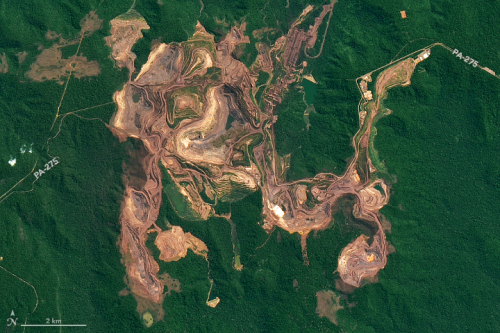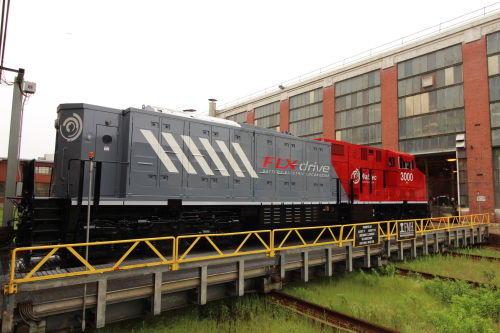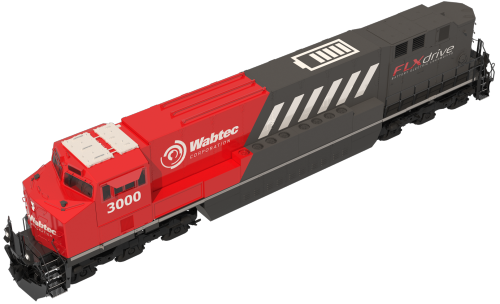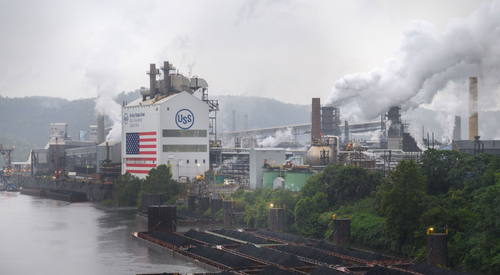Base Metals
Vale partners with Wabtec on ammonia fuel study and orders three FLXdrive battery electric locomotives
Brazil-based metals and mining multinational Vale announced a partnership with Wabtec Corporation to advance the decarbonization of Vale’s rail operations….

Brazil-based metals and mining multinational Vale announced a partnership with Wabtec Corporation to advance the decarbonization of Vale’s rail operations. The deal includes an order for three of Wabtec’s FLXdrive battery locomotives and a collaboration to test ammonia as a potential clean, alternative fuel to replace diesel.
The three 100% battery-powered FLXdrive locomotives will be used on the Carajás Railroad (EFC), which runs the world’s largest iron ore train consisting of 330 railcars transporting 45,000 tons. Today, three to four diesel locomotives pull the train. The EFC runs 972 km (604 miles) from the Carajás Mine in Pará—the world’s largest open pit iron ore mine—to the Maritime Terminal of Ponta da Madeira, in Maranhão. Currently, the complex is responsible for 150 million tonnes of iron per year.
July 2018 Landsat image of the Serra Norte complex of the Carajás Mine.
Once delivered, the FLXdrives will join the diesel locomotives to form Brazil’s first hybrid consist (earlier post) pulling the train uphill for 140 kilometers in Açailândia, in the state of Maranhão, where fuel consumption is the highest. The FLXdrives will replace the two diesel locomotives, known as “dynamic helpers”, that are used to pull the train uphill today.
FLXDrive locomotive similar to those acquired by Vale. Credit: Wabtec
Wabtec will build the FLXdrive locomotives at its plant in Contagem (state of Minas Gerais). The locomotives’ delivery is forecast for 2026.
Initially, we are maximizing energy efficiency, replacing the diesel locomotives in the dynamic helper with battery ones, but the idea is that, in the future, the other locomotives on the train can be fueled by ammonia. This way, we would have a clean operation at EFC. This agreement is the first of many that we are seeking in order to accelerate the decarbonization of our railway operation.
—Vale’s Director of Energy, Ludmila Nascimento
Vale and Wabtec will work together on a study to use ammonia as a clean alternative fuel, which does not emit CO2. The study will initially be carried out as lab tests to validate performance, emission reductions, and feasibility. Among the advantages of ammonia is the fact that it allows the locomotive a longer range than other carbon-free fuels. In addition, ammonia has a high-octane rating and an established large-scale distribution infrastructure. The two companies will carry out the study in a laboratory over the next two years.
The FLXdrive locomotive’s energy management system recharges the batteries along the route as the train brakes.
It’s what we call regenerative energy produced by dynamic braking. Today, that energy is lost when a traditional locomotive brakes. In the downhill sections, we will be able to recharge the batteries, without having to stop the train’s operation.
——Alexandre Silva, Manager of Vale’s Powershift Program.
Vale introduced the Powershift Program to study alternative technologies to replace fossil fuels with clean sources in the company’s operations.
The FLXdrive locomotives are estimated to save 25 million litres of diesel per year, considering the consumption of all the railway’s trains that use the dynamic helper. This savings would reduce carbon emissions by approximately 63,000 tons—the equivalent emissions of around 14,000 passenger cars per year.
Net Zero. In 2020, Vale announced an investment of between US $4 and $6 billion to reduce its direct and indirect emissions (scopes 1 and 2) by 33% by 2030. Today, Vale’s rail network represents 10% of the company’s carbon emissions. The initiative is one more step towards achieving the goal of zero emissions net carbon emissions by 2050, in line with the ambition of the Paris Agreement to limit global warming to below 2°C by the end of the century.
The company also committed to reducing its net emissions from its value chain (scope 3) by 15% by 2035.
One of the world’s largest producers of iron ore and nickel and a major copper producer, Vale is headquartered in Brazil and operates around the world. Its operations comprise integrated logistics systems, including approximately 2,000 kilometers of railways, marine terminals and 10 ports distributed around the globe.

White House Prepares For “Serious Scrutiny” Of Nippon-US Steel Deal
White House Prepares For "Serious Scrutiny" Of Nippon-US Steel Deal
National Economic Adviser Lael Brainard published a statement Thursday…
How to Apply for FAFSA
Students and families will see a redesigned FAFSA this year. Here’s how to fill it out.
Dolly Varden consolidates Big Bulk copper-gold porphyry by acquiring southern-portion claims – Richard Mills
2023.12.22
Dolly Varden Silver’s (TSXV:DV, OTCQX:DOLLF) stock price shot up 16 cents for a gain of 20% Thursday, after announcing a consolidation of…











